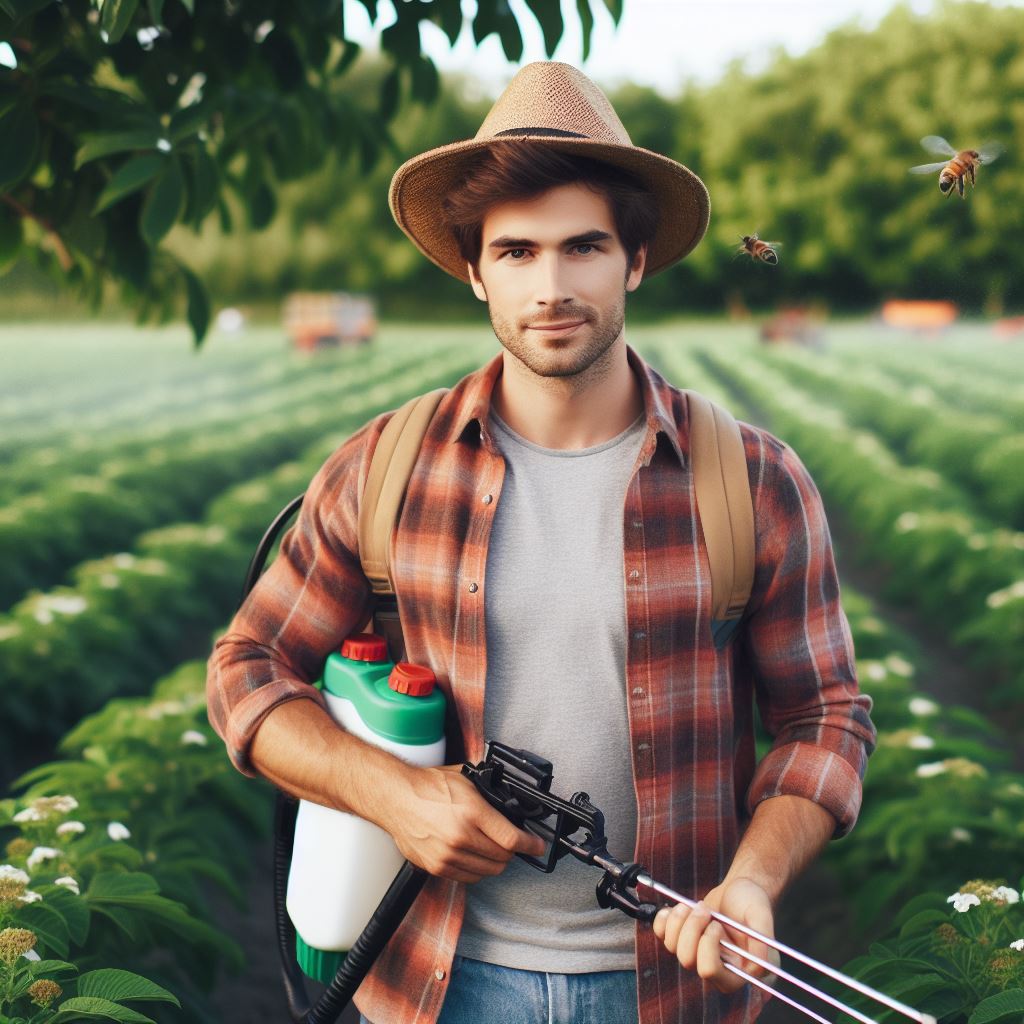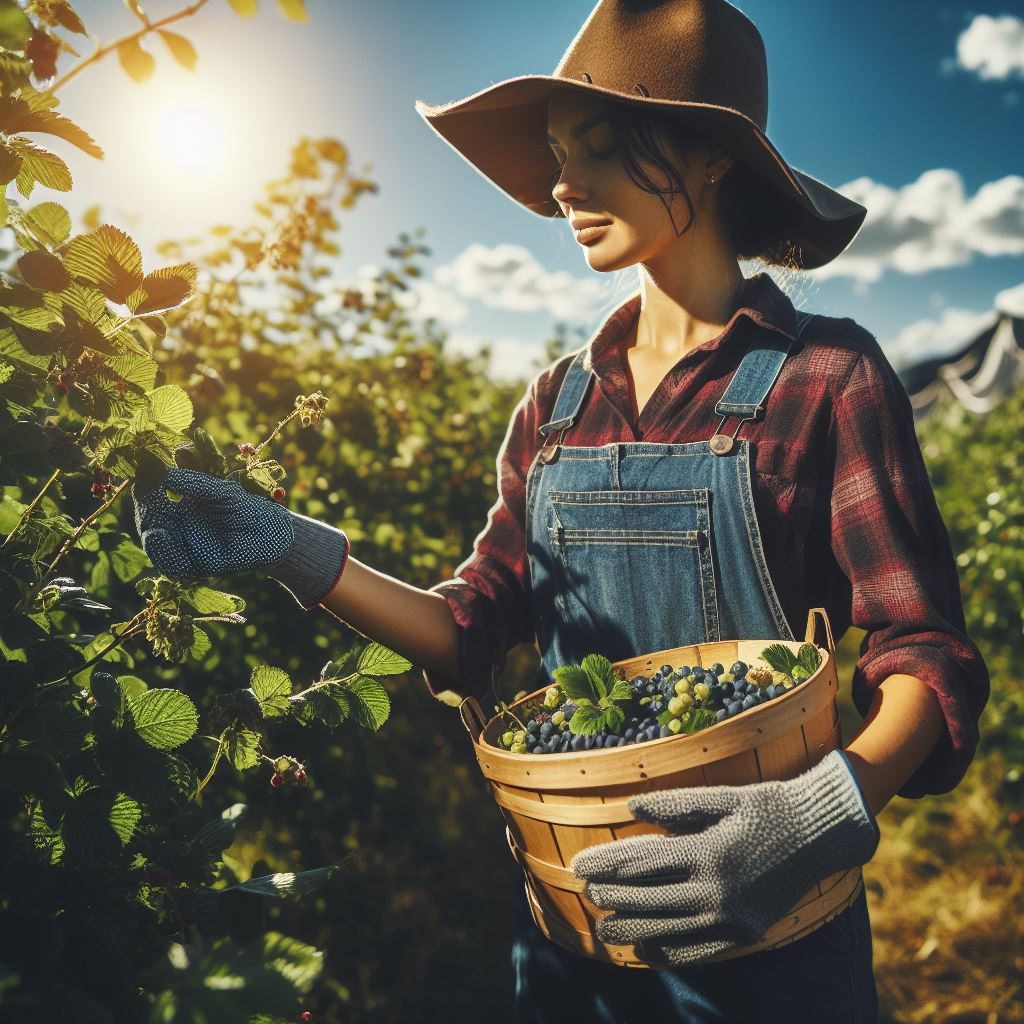Introduction
Brief overview of the importance of pest control in agriculture
Pest control plays a crucial role in agriculture to ensure the health and productivity of crops.
Pest control is crucial in agriculture to protect crops from pests and diseases, ensuring optimal yield and quality. Effective pest management reduces economic losses, promotes food security, and minimizes environmental damage.
It involves various strategies such as monitoring, cultural practices, biological control, and judicious use of pesticides to sustainably maintain crop health.
The topic of protecting crops pre-harvest
Protecting crops pre-harvest is a vital aspect of pest control that deserves attention.
Protecting crops pre-harvest involves implementing strategies to mitigate pest infestations and diseases before harvesting. It encompasses early detection, monitoring, cultural practices, and integrated pest management approaches.
This proactive measure ensures crop health, minimizes yield losses, maintains quality, and supports sustainable agricultural practices for successful harvests.
Objective of the blog post
In this blog post, we will explore the significance of safeguarding crops before they are harvested.
Types of Common Pests
Various pests that commonly attack crops
- Aphids: These small insects feed on plant sap, causing wilting and distorted growth.
- Caterpillars: These larvae of butterflies and moths chew on leaves, leading to defoliation and reduced yield.
- Whiteflies: These tiny insects suck plant sap and transmit viral diseases, causing yellowing and stunted growth.
- Weevils: These beetles feed on crops like grains and fruits, resulting in crop damage and reduced quality.
- Leafhoppers: These insects pierce plant tissues to feed, causing yellowing, leaf curling, and transmission of plant viruses.
Descriptions and characteristics of each pest
- Aphids: They come in various colors, reproduce rapidly, and can be found in large numbers on plant stems and leaves.
- Caterpillars: They have soft bodies, move in a looping motion, and often camouflage themselves to avoid detection.
- Whiteflies: These tiny insects have powdery wings, fly in a jerky manner when disturbed, and lay eggs on the undersides of leaves.
- Weevils: They are small beetles with elongated snouts and hard shells, often found hiding in soil or crop debris.
- Leafhoppers: These small insects have strong hind legs for jumping and can rapidly move from plant to plant.
Potential damage caused by each pest
- Aphids: They weaken plants by sucking out vital nutrients, causing stunted growth and reduced crop yields.
- Caterpillars: Their feeding activity can defoliate plants, leading to a decrease in photosynthesis and lower productivity.
- Whiteflies: They drain sap from plants, reducing their vigor and promoting the growth of sooty molds.
- Weevils: These pests damage crops by feeding on seeds, fruits, and leaves, resulting in reduced quality and economic losses.
- Leafhoppers: They transmit harmful plant viruses, affecting plant health and reducing crop yield and quality.
In short, understanding the different types of common pests that frequently attack crops is crucial for effective pest control strategies.
Aphids, caterpillars, whiteflies, weevils, and leafhoppers are just a few examples of pests that can cause significant damage to crops.
By recognizing their descriptions, characteristics, and the potential harm they can cause, farmers and gardeners can implement appropriate preventive and control measures to protect their crops pre-harvest.
Read: Storing Potatoes: Post-Harvest Tips
Identifying Infestations
The Significance of Early Pest Detection
Early detection of pests is crucial in effectively controlling infestations and minimizing crop damage. By identifying pests at their early stages, farmers can take immediate action to protect their crops.
- Reduced Crop Losses: Identifying pests early allows farmers to implement preventive measures promptly, reducing the risk of significant crop losses.
- Efficient Resource Allocation: Early detection saves farmers time and resources by preventing the need for more extensive and expensive pest control methods later on.
- Effective Pest Management: Early pest detection enables farmers to adapt their pest management strategies quickly and efficiently, increasing the chances of successful crop protection.
Visual Signs and Symptoms of Infestations
Recognizing the visual signs and symptoms of infestations is essential for identifying and addressing potential pest problems in crops.
- Visible Damage: Inspecting plants for signs of physical damage, such as chewed leaves, holes, and wilting, can indicate the presence of pests.
- Discolored Leaves: Yellowing, browning, or spotted leaves are often an indication of pest activity, such as aphids or fungal infections.
- Presence of Pests: Identifying pests directly on plants, such as caterpillars, beetles, or mites, confirms the existence of an infestation.
Techniques for Monitoring and Identifying Pests
Implementing effective monitoring techniques is crucial for accurately identifying pest infestations and taking timely action.
- Visual Inspections: Regularly inspecting plants by visually scanning for pests or their damage is a fundamental monitoring technique.
- Traps and Baits: Placing traps, bait stations, or sticky sheets in the field helps capture and monitor pests, providing insights into their population dynamics.
- Pheromone Traps: Using synthetic pheromones specific to certain pests attracts them into traps, aiding in their identification and monitoring.
- Crop Scouting: Systematically sampling plants across the field allows farmers to identify the presence and severity of pests in different areas.
- Remote Sensing: Utilizing drones or satellite imagery can provide a broader overview of crop health, helping identify potential pest hotspots.
- Expert Consultation: Seeking advice from agricultural experts or experienced pest control professionals can help identify pests accurately and determine appropriate control measures.
- Pest Identification Guides: Referring to comprehensive pest identification guides or online resources helps farmers recognize specific pests and their characteristics.
In essence, early pest detection plays a pivotal role in protecting crops pre-harvest.
The ability to spot visual signs and symptoms of infestations, combined with effective monitoring techniques, empowers farmers to take proactive measures against pests, reducing crop losses and ensuring successful pest control management.
Transform Your Agribusiness
Unlock your farm's potential with expert advice tailored to your needs. Get actionable steps that drive real results.
Get StartedBy remaining vigilant and staying informed, farmers can safeguard their crops and maximize their agricultural productivity.
Read: Apple Picking: Timing for Perfect Fruit
Preventing Pest Infestations
Preventing pest infestations is crucial in protecting crops and ensuring successful harvests.
Cultural Practices to Minimize Pest Attraction
By implementing cultural practices, farmers can minimize pest attraction and establish a healthier growing environment.
Implement proper sanitation measures to remove and destroy breeding grounds for pests.
Regularly remove and properly dispose of diseased plants or crop residues to prevent pest buildup.
Practice good weed control to eliminate weed hosts that attract and harbor pests.
Promote healthy plant growth through proper nutrition and irrigation to reduce plant stress and vulnerability to pests.
Encourage beneficial insects and organisms that prey on pests by providing habitat and food sources.
Importance of Crop Rotation
Crop rotation is another effective method for preventing pest infestations.
Rotate crops to disrupt pest life cycles and reduce their buildup in the soil.
Planting different crops in alternating seasons can help break the cycle of pest infestations.
Rotation also helps in preventing the accumulation of pathogenic organisms specific to certain crop species.
It improves soil health by maintaining nutrient balance and reducing soil-borne diseases.
Benefits of Selecting Resistant Crop Varieties
Selecting resistant crop varieties is an essential strategy in pest control.
Choose crop varieties that have natural resistance or tolerance to common pests.
This reduces the need for chemical pesticides, minimizing their environmental impact.
Resistant crop varieties can withstand pest attacks better, leading to higher yield and productivity.
They ensure the continuation of crop production even in the presence of pests.
Methods for Physical Barriers or Deterrents
Incorporating physical barriers or deterrents can also help protect crops from pests.
Install fences or netting to physically prevent pests from accessing crops.
Use row covers or floating row covers to protect crops from flying insects.
Implement scare devices like reflective tapes, noise makers, or visual repellents to deter pests.
Employ traps, sticky cards, or barriers like insect tape to catch or block crawling insects.
Showcase Your Farming Business
Publish your professional farming services profile on our blog for a one-time fee of $200 and reach a dedicated audience of farmers and agribusiness owners.
Publish Your ProfileApply repellent plants, such as marigolds or garlic, around the perimeter to deter pests.
By implementing these preventive measures, farmers can reduce the reliance on chemical pesticides, create a healthier growing environment, and ultimately protect their crops from pest infestations.
Read: Maximizing Wheat Yields: Harvesting Insights

Natural and Biological Pest Control
Advantages of Using Natural Pest Control Methods
- Eco-Friendly: Natural pest control methods help protect the environment and reduce the use of harmful chemicals.
- Safe for Humans and Animals: Unlike chemical pesticides, natural control methods do not pose health risks to humans and animals.
- Cost-Effective: Natural control methods are often more affordable than chemical solutions, reducing production costs for farmers.
- Sustainable: Natural pest control methods can be used in the long term without negatively impacting soil quality or crop yield.
Beneficial Insects or Predators in Pest Management
- Ladybugs: These beetles feed on aphids, mealybugs, and other crops-damaging pests.
- Lacewings: Lacewing larvae prey on aphids, spider mites, and caterpillars, providing natural pest control.
- Predatory Wasps: Certain species of wasps help control agricultural pests by parasitizing their eggs or larvae.
- Praying Mantises: These predators consume a variety of insects, including caterpillars, beetles, and grasshoppers.
The Effectiveness of Biological Control
- Targeted Approach: Biological control methods specifically target the pests without harming beneficial insects or pollinators.
- Long-Term Results: Establishing a balance between pests and beneficial organisms can lead to sustainable pest control.
- Reduced Resistance: Biological control methods reduce the chances of pest populations developing resistance to pesticides.
- Low Environmental Impact: Biological control minimizes the use of chemical pesticides, protecting biodiversity and ecosystems.
Examples of Biological Agents for Pest Control
- Trichogramma Wasps: These tiny wasps lay their eggs inside pest eggs, preventing them from hatching.
- Nematodes: These microscopic worms attack and kill insects, larvae, and soil-dwelling pests.
- Bacillus thuringiensis (Bt): A naturally occurring bacteria that produces toxins lethal to specific insect pests.
- Entomopathogenic Fungi: Fungi such as Beauveria bassiana infect and kill various insect pests.
In the end, natural and biological methods offer numerous advantages for pest control in agriculture. They are environmentally friendly, safe, cost-effective, and sustainable.
Beneficial insects and predators play a crucial role in managing pests, while biological control methods provide targeted and long-term solutions.
Utilizing biological agents like trichogramma wasps, nematodes, Bt, and entomopathogenic fungi further enhances pest control efforts.
By embracing natural and biological pest control, farmers can protect their crops effectively while minimizing the impact on the environment.
Read: Efficient Cotton Picking Methods Explained
Chemical Pest Control
Role of Chemical Pesticides in Crop Protection
Chemical pesticides play a crucial role in protecting crops from pests.
They are designed to control and eliminate harmful insects, weeds, and diseases.
These pesticides are effective in reducing crop losses and increasing agricultural productivity.
They can target specific pests and minimize damage to crops, leading to higher yields.
Considerations and Precautions when Using Chemical Pesticides
Before using chemical pesticides, it is important to assess the severity of the pest problem.
Proper identification of the pest is crucial to determine the right pesticide for effective control.
Consider the potential risks to human health, environment, and non-target organisms.
Follow integrated pest management practices to minimize reliance on chemical pesticides.
Select pesticides that have low toxicological and environmental impact.
Adhere to recommended dosage and application methods to ensure effectiveness and safety.
Prioritize the use of less harmful alternatives, such as biological control or cultural practices.
Importance of Following Label Instructions and Safety Guidelines
Label instructions provide critical information on proper pesticide handling, storage, and disposal.
Pesticide labels include recommended application rates, timing, and specific precautions.
Read and understand the label thoroughly before using any chemical pesticide.
Failing to follow label instructions may result in ineffective pest control or unintended harmful consequences.
Always wear appropriate protective equipment, such as gloves, goggles, and masks, when handling pesticides.
Ensure proper ventilation during application to minimize exposure to potentially harmful fumes.
Store pesticides in a secure location away from children, pets, food, and water sources.
Dispose of pesticide containers and unused products according to local regulations to prevent contamination.
Chemical pest control has revolutionized crop protection by providing efficient and targeted methods against pests. However, it is essential to use chemical pesticides responsibly.
Integrated pest management strategies should always be considered, prioritizing non-chemical alternatives whenever possible.
Following label instructions and safety guidelines ensures the safe and effective use of chemical pesticides, minimizing risks to human health and the environment.
By balancing the benefits of chemical pest control with its potential drawbacks, farmers can protect their crops while preserving the long-term sustainability of agricultural practices.
Gain More Insights: Irrigation Tech: Smart Water Management
Integrated Pest Management (IPM) Approach
Definition Integrated Pest Management (IPM)
Integrated Pest Management (IPM) refers to a comprehensive approach that combines various pest control methods to manage and prevent pest damage in a sustainable manner.
Benefits of adopting an IPM approach
- Effective pest control: IPM utilizes multiple strategies to control pests, ensuring a more successful and long-term solution.
- Reduced reliance on pesticides: By integrating different control methods, IPM minimizes the need for chemical pesticides, reducing harm to crops and the environment.
- Cost-effective: IPM helps farmers save money by targeting specific pests and minimizing crop damage, resulting in reduced losses and increased profitability.
- Environmental sustainability: This approach promotes ecological balance by preserving beneficial organisms and reducing pesticide runoff, protecting biodiversity.
- Health safety: By decreasing pesticide use, IPM reduces potential health risks for farmers, consumers, and farm workers.
Various components of an IPM program
- Monitoring: Regularly inspecting crops to detect pest presence, population levels, and potential damage is crucial in IPM.
- Pest identification: Accurate identification helps farmers choose the most appropriate control methods for each specific pest.
- Prevention: Implementing preventive measures such as crop rotation, habitat manipulation, and using pest-resistant cultivars reduce the need for control measures.
- Cultural control: Employing practices like proper irrigation, pruning, and removing weed hosts can disrupt pest life cycles and reduce their impact.
- Biological control: Encouraging natural predators, parasites, or pathogens that attack pests can provide effective control without chemical intervention.
- Mechanical control: Physical methods like barriers, traps, and tillage techniques can physically deter or suppress pests.
- Chemical control: If all other methods are insufficient, targeted pesticide application becomes an option, but only as a last resort in IPM.
Practical examples of implementing IPM strategies pre-harvest
- Crop rotation: Alternating the cultivation of different crops disrupts pest life cycles and reduces their buildup.
- Sanitation practices: Regularly removing and disposing of crop residues helps eliminate potential pest breeding grounds.
- Implementing farm hygiene: Maintaining clean and organized farm premises reduces pest access and helps monitor pest populations.
- Using insect traps: Placing sticky traps or pheromone traps in fields can help monitor pest populations and determine the need for control measures.
- Biological control agents: Introducing predacious insects, beneficial microorganisms, or using biopesticides can effectively control pests.
- Physical barriers: Installing nets, screens, or fences can physically prevent pests from accessing crops.
- Timely harvesting: Harvesting crops at the right time minimizes opportunities for pest infestation or damage.
By adopting an Integrated Pest Management (IPM) approach, farmers can effectively protect their crops, reduce environmental impact, and maintain sustainable agricultural practices.
Conclusion
Recap the main points discussed in the blog post
In this blog post, we discussed the importance of pest control in protecting crops before they are harvested.
The pre-harvest pest control topic emphasizes early detection, monitoring, and integrated approaches like cultural practices and biological control methods.
It stresses the importance of addressing infestations to ensure healthy crop growth, minimize yield losses, and maintain quality, supporting sustainable farming practices for successful harvests and crop protection.
Emphasis on the importance of pest control for crop protection
Pest control is crucial for crop protection as it helps prevent significant yield losses and damage to crops.
Pest control is paramount for safeguarding crops from infestations and diseases, ensuring optimal growth, yield, and quality. Early detection, integrated strategies, and preventive measures mitigate risks, sustaining crop health and productivity.
Showcase Your Farming Business
Publish your professional farming services profile on our blog for a one-time fee of $200 and reach a dedicated audience of farmers and agribusiness owners.
Publish Your ProfileEffective pest management practices are vital for securing food supplies, supporting agriculture, and fostering sustainable farming practices globally.
Encouraging readers to prioritize pre-harvest pest control for successful farming
We encourage readers to prioritize pre-harvest pest control to ensure successful and sustainable farming.
Prioritizing pre-harvest pest control is crucial for ensuring successful farming outcomes.
By implementing proactive strategies like early detection, monitoring, and integrated pest management, farmers can safeguard their crops against potential threats, optimize yields, and sustain agricultural productivity.
Investing in preventive measures enhances crop health and contributes to long-term farming success.




